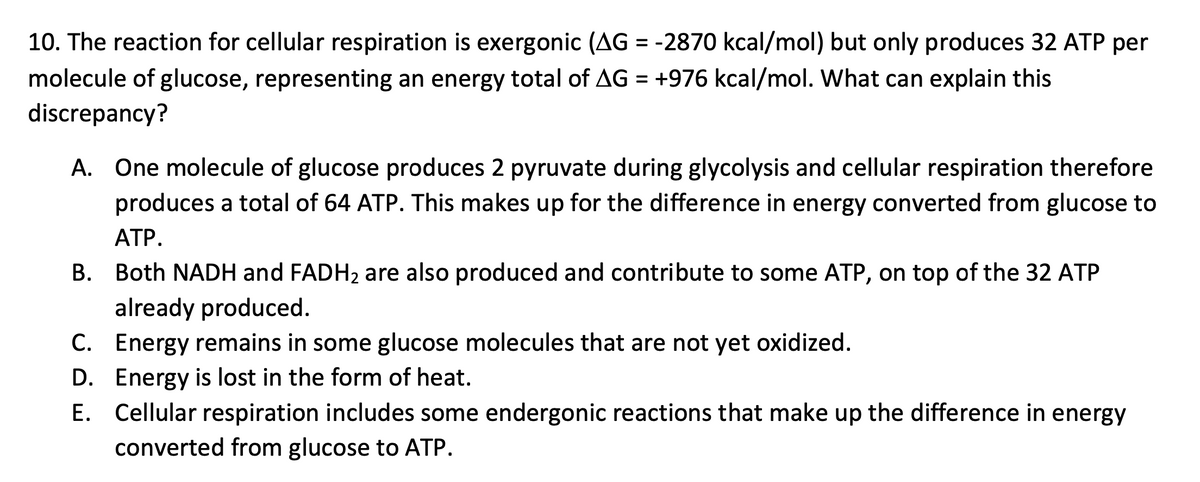10. The reaction for cellular respiration is exergonic (AG = -2870 kcal/mol) but only produces 32 ATP per molecule of glucose, representing an energy total of AG = +976 kcal/mol. What can explain this discrepancy? A. One molecule of glucose produces 2 pyruvate during glycolysis and cellular respiration therefore produces a total of 64 ATP. This makes up for the difference in energy converted from glucose to ATP. B. Both NADH and FADH₂ are also produced and contribute to some ATP, on top of the 32 ATP already produced. C. Energy remains in some glucose molecules that are not yet oxidized. D. Energy is lost in the form of heat. E. Cellular respiration includes some endergonic reactions that make up the difference in energy converted from glucose to ATP.
10. The reaction for cellular respiration is exergonic (AG = -2870 kcal/mol) but only produces 32 ATP per molecule of glucose, representing an energy total of AG = +976 kcal/mol. What can explain this discrepancy? A. One molecule of glucose produces 2 pyruvate during glycolysis and cellular respiration therefore produces a total of 64 ATP. This makes up for the difference in energy converted from glucose to ATP. B. Both NADH and FADH₂ are also produced and contribute to some ATP, on top of the 32 ATP already produced. C. Energy remains in some glucose molecules that are not yet oxidized. D. Energy is lost in the form of heat. E. Cellular respiration includes some endergonic reactions that make up the difference in energy converted from glucose to ATP.
Biology: The Dynamic Science (MindTap Course List)
4th Edition
ISBN:9781305389892
Author:Peter J. Russell, Paul E. Hertz, Beverly McMillan
Publisher:Peter J. Russell, Paul E. Hertz, Beverly McMillan
Chapter6: Energy, Enzymes, And Biological Reactions
Section: Chapter Questions
Problem 7TYK: In an enzymatic reaction: a. the enzyme leaves the reaction chemically unchanged. b. if the enzyme...
Related questions
Topic Video
Question

Transcribed Image Text:10. The reaction for cellular respiration is exergonic (AG = -2870 kcal/mol) but only produces 32 ATP per
molecule of glucose, representing an energy total of AG = +976 kcal/mol. What can explain this
discrepancy?
A. One molecule of glucose produces 2 pyruvate during glycolysis and cellular respiration therefore
produces a total of 64 ATP. This makes up for the difference in energy converted from glucose to
ATP.
B. Both NADH and FADH₂ are also produced and contribute to some ATP, on top of the 32 ATP
already produced.
C. Energy remains in some glucose molecules that are not yet oxidized.
D. Energy is lost in the form of heat.
E. Cellular respiration includes some endergonic reactions that make up the difference in energy
converted from glucose to ATP.
Expert Solution
This question has been solved!
Explore an expertly crafted, step-by-step solution for a thorough understanding of key concepts.
Step by step
Solved in 4 steps

Knowledge Booster
Learn more about
Need a deep-dive on the concept behind this application? Look no further. Learn more about this topic, biology and related others by exploring similar questions and additional content below.Recommended textbooks for you

Biology: The Dynamic Science (MindTap Course List)
Biology
ISBN:
9781305389892
Author:
Peter J. Russell, Paul E. Hertz, Beverly McMillan
Publisher:
Cengage Learning

Biology (MindTap Course List)
Biology
ISBN:
9781337392938
Author:
Eldra Solomon, Charles Martin, Diana W. Martin, Linda R. Berg
Publisher:
Cengage Learning

Biology: The Dynamic Science (MindTap Course List)
Biology
ISBN:
9781305389892
Author:
Peter J. Russell, Paul E. Hertz, Beverly McMillan
Publisher:
Cengage Learning

Biology (MindTap Course List)
Biology
ISBN:
9781337392938
Author:
Eldra Solomon, Charles Martin, Diana W. Martin, Linda R. Berg
Publisher:
Cengage Learning